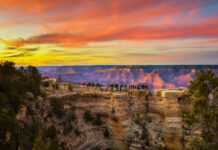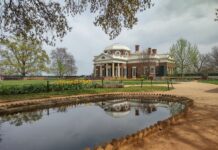 In downtown Asheville, N.C., live music is everywhere. Jazz blows from open-door cafés, bluegrass twangs out of the clubs and Southern rock pulses from talented street performers. Drumming, chanting, whooping and clapping reverberates from Pritchard Park, where musicians, families, hippies and business folks— ties and jackets tossed aside— are dancing and rapping to the beat in the traditional Friday night Drum Circle.
In downtown Asheville, N.C., live music is everywhere. Jazz blows from open-door cafés, bluegrass twangs out of the clubs and Southern rock pulses from talented street performers. Drumming, chanting, whooping and clapping reverberates from Pritchard Park, where musicians, families, hippies and business folks— ties and jackets tossed aside— are dancing and rapping to the beat in the traditional Friday night Drum Circle.
I mosey into Malaprops Bookstore, where author Prioleau Alexander is staging a reading from his book about white-collar burnout. Later, the shop will be hosting poets for Wordfest, a citywide poetry and literature event. Down the block, crowds are filing into an exhibition at Woolworth Walk, a restored five-and-dime–turned-gallery with a lively vintage soda fountain.
Later, at N.C. Stage, I catch a public rehearsal of “The Crucible,” whose cast includes local resident Tim Carhart, who played the infamous redneck molester in the movie “Thelma and Louise.”
Back outside, people are strolling, checking out menus, drifting out of evening yoga classes and rummaging in the wine shop.
Within this convivial, vivacious setting, it is beginning to dawn on me why so many tourists wind up as residents.
In his book, “The Geography of Bliss,” Eric Weiner dubs Asheville the happiest city in the United States. He notes that “Asheville is big enough to have a thriving arts scene and choice of restaurants, yet not so big that it is burdened with big city problems, such as traffic jams and high crime rates… a five-minute drive can take you deep into the woods or deep in a Thai restaurant.”
ABC’s “20/20” recently sang Asheville’s praises as well with its own program on happiness. Both the book and the news broadcast proclaimed what its residents already knew: Asheville’s cohesiveness, civility, spiritual tolerance and powerful natural surroundings all make for one happy populace.
Having spent many summers at a camp in the Blue Ridge Mountains, I was well aware of the bewitching beauty of the region. Then, when my Zen Buddhist friends relocated from Santa Fe, N.M., to Asheville, seeking a more authentic organic-minded community, my husband and I booked a trip in an attempt to discover what this magical place is all about.
 Asheville itself lies in glorious surroundings, bordered by steams and lakes, hot springs, mountains and meadows containing the most diverse collection of herbs in the country. In the mid-1800s, the first tourists arrived by railroads to “take to the waters,” breathe in the therapeutic mountain air and seek improved health via those wild herbs, reputedly rich with healing properties. In the late 1800s, artisans and crafters were commissioned to Asheville to construct the Vanderbilts’ summer residence, Biltmore, which, within its self-sustaining design, set the model for the region’s prevailing farm-to-table movement. F. Scott and Zelda Fitzgerald and Thomas Wolfe, whose mother ran a boardinghouse here called The Old Kentucky Home, were its most famous residents in the 1930s.
Asheville itself lies in glorious surroundings, bordered by steams and lakes, hot springs, mountains and meadows containing the most diverse collection of herbs in the country. In the mid-1800s, the first tourists arrived by railroads to “take to the waters,” breathe in the therapeutic mountain air and seek improved health via those wild herbs, reputedly rich with healing properties. In the late 1800s, artisans and crafters were commissioned to Asheville to construct the Vanderbilts’ summer residence, Biltmore, which, within its self-sustaining design, set the model for the region’s prevailing farm-to-table movement. F. Scott and Zelda Fitzgerald and Thomas Wolfe, whose mother ran a boardinghouse here called The Old Kentucky Home, were its most famous residents in the 1930s.
Many of those artisans who built the Biltmore remained, launching a still-burgeoning, multi-generational arts and crafts community that has lent an alt-culture vibe to the town ever since. Or as one woman I met summed up: “Asheville is Greenwich Village in the mountains.”
And like New York City, I find that in this town of 72,000, there’s always something to do. “Asheville is a continuous festival; the plays, the concerts. … There is something going on every 10 feet downtown,” says Jonas Gerard, a painter located in the River Arts District, a warehouse district along the French Broad River where many of Asheville’s 4,000 artisans and craftspeople work and run galleries.
Gerard, who was interviewed in the “20/20” program, is an undisputedly happy, colorful character emblematic of the blissful spirit that prevails among Ashevillians. Bouncy rock music streams from his studio as he works. The nationally known abstract expressionist with a penchant for bold, bright colors is a strong proponent of the district’s open studio policy; visitors wander in to find him be-bopping while dabbing paintbrushes onto canvas. Tiny signs announce “It’s Okay To Touch.” From within this communal rehabbed warehouse district of artisans and foundries, Gerard says, “Coming to Asheville has been the most loving, sweetest experience of my life. There is a unity here that bonds everyone to everyone else.”
The River Arts District is a fun place to wander, as most artist studios lie within a quick walk or drive of one another. I poke my head into a dozen of them and meet creative types of every sort. There are a few coffee shops and restaurants sprinkled about as well, but instead I head to Asheville’s famed Savoy restaurant, where, over appetizers of grilled figs, prosciutto and goat cheese, I meet chef and owner Eric Scheffer. Scheffer decided to move here 13 years ago after gazing at the mountains with his wife during a Thanksgiving visit. Without much afterthought, he tossed aside his family’s film and televison production business in Los Angeles and entrenched himself in Asheville.
Scheffer is rapt with the region’s readily available herbs and produce. Farmers deliver to his back door, and he has purchased a farm nearby to cultivate his own produce and meats. “I live this great adventure every day in my own restaurant,” Scheffer tells me. That is apparent as he effortlessly darts between supervising the kitchen and entertaining his customers, many of whom fly their private planes for a meal here.
 Another popular restaurant among Ashevillians is The Market Place, located downtown. Owner Mark Rosenstein integrates local ingredients into his seasonal menus from nearby farms, gardens and fisheries. His new casual dining room, Bar 100, features a menu based upon ingredients available within 100 miles.
Another popular restaurant among Ashevillians is The Market Place, located downtown. Owner Mark Rosenstein integrates local ingredients into his seasonal menus from nearby farms, gardens and fisheries. His new casual dining room, Bar 100, features a menu based upon ingredients available within 100 miles.
Rosenstein, like many of Asheville restaurateurs, is a regular at Asheville’s Saturday morning “tailgates,” the name for its dozens of regional organic farmers’ markets.
I visit two, including Asheville City Market, which features more than 60 vendors in a parking lot beneath a viaduct. (Something like Baltimore’s own downtown farmers’ market beneath I-83.) The scene is at once retro-small town and New Age, a mix of old-time farmers selling plump pole beans and modern-day cultivators dispensing beeswax candles. It’s also a great way to get a taste (literally) of that Asheville bliss.
Upon spotting me, the newcomer, the vendors strike up genuine conversation and offer up samples of their wares— everything from artisan cheeses to fresh whole-grain breads. How could anyone not be happy here? I buy a bag of nuts and a hunk of hard cheese for a snack— and a bar of lemongrass soap for my teenage daughter back home.
 I learn from the locals that the farm-to-table movement isn’t the only progressive idea popular in Asheville. The Five Day Weekend Movement, a national push to reverse the workweek, is based here and another, Strive Not to Drive, encourages the local work force to stay out of their cars and in-town at lunchtime, promoting healthy living, local businesses and the environment.
I learn from the locals that the farm-to-table movement isn’t the only progressive idea popular in Asheville. The Five Day Weekend Movement, a national push to reverse the workweek, is based here and another, Strive Not to Drive, encourages the local work force to stay out of their cars and in-town at lunchtime, promoting healthy living, local businesses and the environment.
So, let’s see, so far we’ve got a great arts district, live music of every sort, excellent restaurants specializing in local produce, farmers markets seemingly everywhere and a local movement that espouses working just two days a week. Who wouldn’t be happy here?
But you can’t visit Asheville without taking in the spectacular mountain scenery, so one early morning we pack a picnic and head out on the Blue Ridge Parkway for a hike at Max Patch Bald, a favorite trek of locals. After exiting the highway, a smaller road takes us through breathtaking, classic mountain communities with split-rail fences, red tobacco barns and covered bridges. It’s just a half-mile hike up to the 4,629-foot summit, which, as its name implies, is bald of trees and shrubs— nothing but grass. But the view extends for miles— all the way across eastern Tennessee, and beyond the Great Smokies. Even the most jaded can’t help but feel humbled.
Looking out, I think of the people I’ve met in Asheville and what author Weiner meant when he wrote “our happiness is completely and utterly entwined with other people…happiness is not a noun or a verb, it’s a conjunction.” And in Asheville, those conjunctions occur in some of the most blissful ways.
Getting there
US Airways flies from BWI. You will change in Charlotte, but locals say it’s quicker to drive the 90 minutes yourself. For tourism information, see http://www.exploreasheville.com.
STAY
The pampered people opt for the scenic Grove Park Inn and Spa (828-252-2711, http://www.groveparkinn.com). Those seeking the “grand experience” should book a room at The Biltmore (800-438-5800, http://www.biltmore.com). The crunchy-minded head to Hawk & Ivy (828-626-3486, http://www.hawkandivy.com), a holistic B&B farm whose owner leads Asheville’s Slow Food movement.
EAT
For imaginative cuisine, made with local ingredients, try The Marketplace (828-252-4162, http://www.marketplace-restaurant.com). A bit out of town but worth it is The Savoy (828-253-1077, http://www.savoyasheville.com). Don’t miss the organic chocolate “sipping truffles” at The French Broad Chocolate Lounge (828-252-4181, http://www.frenchbroadchocolates.com).
PLAY
For listings of tailgates, farms, growers and organic grocers: http://www.buyappalachian.org. For a guide to the River Arts District, check out http://www.riverdistrictartists.com.




